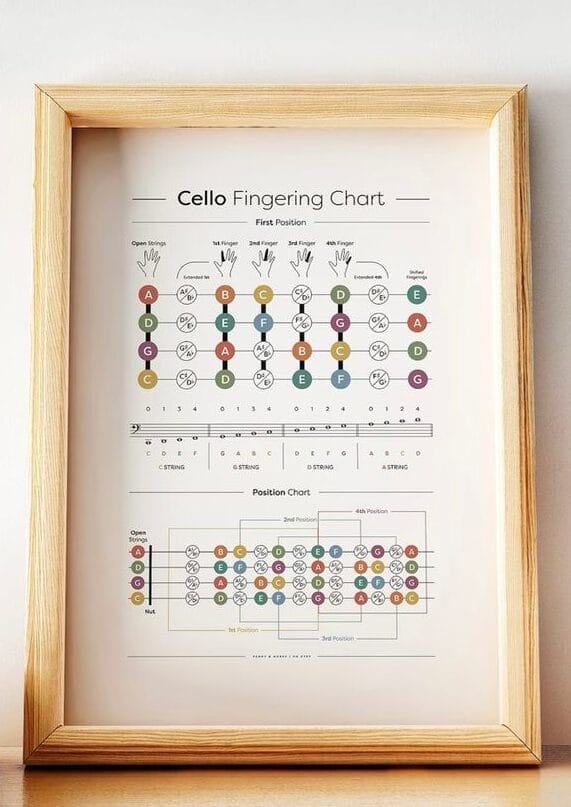If you’re learning the cello, you might have heard of something called a “studio chart.” But what exactly is it, and why is it important? A studio chart is a tool used by cellists to organize and improve their practice. It helps track your progress, understand musical notes, and become a better player. Let’s dive in and explore what a studio chart for cello looks like and how it can help you in your musical journey.
What Is a Studio Chart for Cello?
A studio chart is like a map for your cello practice. It shows you which notes to play, how fast or slow to play them, and when to use special techniques. Think of it as a guide that helps you navigate through your music.
For cellists, studio charts are essential for understanding music better. Whether you’re just starting or are more advanced, a good studio chart can help you master the cello faster by breaking down difficult sections and helping you stay organized.

Key Components of a Cello Studio Chart
A studio chart for cello contains several important elements. Let’s take a closer look at each of them:
1. Staff Lines & Notation
The most important part of the studio chart is the staff. This is where the notes live. Each line and space represents a different pitch or note. As you read the notes, you’ll know which strings to use and where to place your fingers.
2. Bowings & Fingerings
Bowing refers to how you move the bow across the strings. Some sections will require long, smooth bow strokes, while others need short, quick ones. Fingerings tell you which fingers to use on each string. This makes playing easier and more accurate.
3. Rhythmic Patterns
Rhythms show the timing of the notes. A studio chart will tell you when to play each note and how long to hold it. This ensures that you are playing on time, which is essential when practicing or playing in an ensemble.
4. Tempo Markings
Tempo tells you how fast or slow to play a piece. For example, if the studio chart says “Allegro,” you’ll know how to play quickly. Tempo helps give the music its character and mood, so it’s important to follow it closely.
5. Dynamic Markings
Dynamics indicate how loud or soft to play. This adds emotion and expression to the music. A soft passage (marked with “p” for “piano”) may sound gentle, while a loud one (marked “f” for “forte”) gives the music more energy.
6. Articulations
Articulations are special symbols that show how to play individual notes. For example, a dot above a note means to play it short and detached (staccato), while a line means to play it smoothly (legato).
7. Ornamentations
These are extra decorations that make the music sound more interesting. Trills, grace notes, and slides are some common ornamentations you’ll find on a studio chart. They add flair and show off your technical skills.
Why Studio Charts Are Essential for Cello Practice
Studio charts aren’t just for show—they are tools that can make a real difference in how well you play the cello. Here are a few reasons why they’re essential:
- Organized Practice: Studio charts help you focus on the right sections of music, making practice more efficient.
- Clear Goals: They set clear expectations for each practice session, so you always know what to work on.
- Improves Skills: Regularly following a studio chart can help you improve finger technique, bowing, and overall musicality.
Whether you’re practicing solo or preparing for an orchestra, studio charts guide you every step of the way.
Types of Cello Studio Charts
Not all studio charts are the same. There are different types based on what you’re practicing. Let’s explore a few:
1. Solo Repertoire Charts
These charts focus on individual pieces that are meant to be played alone. They highlight difficult passages and provide tips for mastering the music.
2. Orchestral Studio Charts
When you’re part of an orchestra, it’s important to know how your part fits with others. These charts help you understand your role in a larger group and keep track of your cues.
3. Etudes and Exercises
Etudes are short pieces that focus on improving technique. A studio chart for etudes breaks down fingerings, bowings, and rhythms to help you master tricky sections.
4. Scales and Arpeggios Charts
Scales and arpeggios are the building blocks of music. These charts help you practice them in a structured way, improving your hand coordination and finger strength.
How to Read and Use a Studio Chart Effectively
Learning to read a studio chart might feel overwhelming at first, but with practice, it becomes second nature. Here’s a simple guide to get you started:
- Start with the Basics: Focus on the notes and rhythms first. Make sure you’re playing the right notes in time.
- Follow the Dynamics: Pay attention to dynamic markings, as they will make your performance more expressive.
- Practice Slowly: Don’t rush. Start at a slow tempo and gradually increase your speed as you get more comfortable.
- Take Notes: Write down any tricky spots or bowings that need more work. This will help you track your progress.
- Be Consistent: Regular practice with a studio chart will show steady improvement over time.
Conclusion
Studio charts for cello are essential tools that help you become a better musician. From understanding rhythms to improving your fingerings, these charts offer a roadmap to success. Whether you’re a beginner or an advanced cellist, using a studio chart will help you master your music and reach your full potential.

